Mash up: Human-Centred Design & Business Model Canvas
A few weeks ago I posted a mash-of Larry Keeley’s Ten Types of Innovation and Alexander Osterwalder’s and Yves Pigneur’s Business Model Canvas (BMC).

I also mentioned that I’ll look at mashing up Human-Centred Design (HCD) and the BMC.
So, first I tried to see how LUMA’s Taxonomy of Innovation (Part of LUMA Institute’s System of Innovation, using Human-Centered Design Methods) might fit with the BMC.
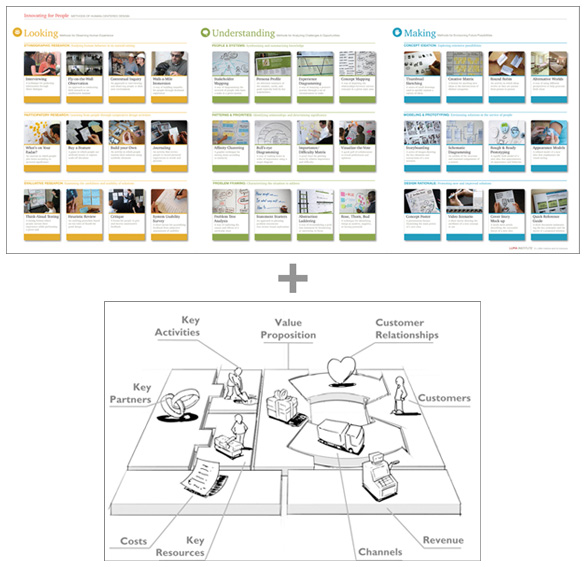
Image: LUMA’s Taxonomy of Innovation (Part of LUMA Institute’s System of Innovation, using Human-Centered Design Methods) + Business Model Canvas (from Business Model Generation by Osterwalder and Pigneur)
Curious about whether the individual methods could be mapped to the canvas I tried the following.
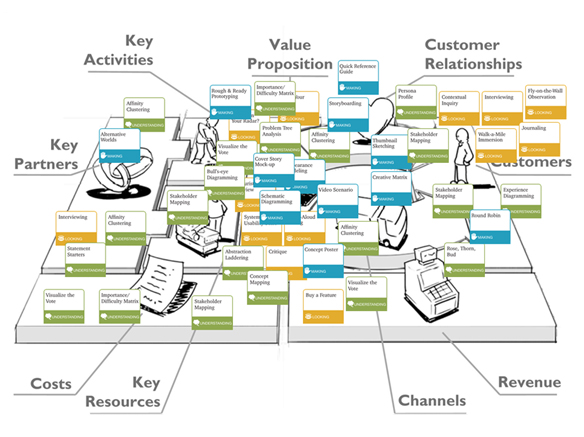
Which is completely mental and just plain wrong, for many, many reasons – mostly because the LUMA HCD taxonomy (as represented by the categories of Looking, Understanding, and Making) is meant to be more like a periodic table of elements – some elements combine nicely with other elements to give you a useful compound. An element on its own is not particularly useful and you don’t know how it’s going to react until you put it in particular atmosphere with other elements. That’s why the LUMAtics recommend arranging the methods into method sets that can be applied to a particular problem or situation.

So, I looked at how HCD methods could be combined into method sets and applied to tackle challenges within a specific building block of the BMC, the Customer Segment.
According to Osterwalder and Pigneur understanding customers is critical because it informs choices we’ll make on the Value Proposition, Channel, Customer Relationship and Revenue Streams.
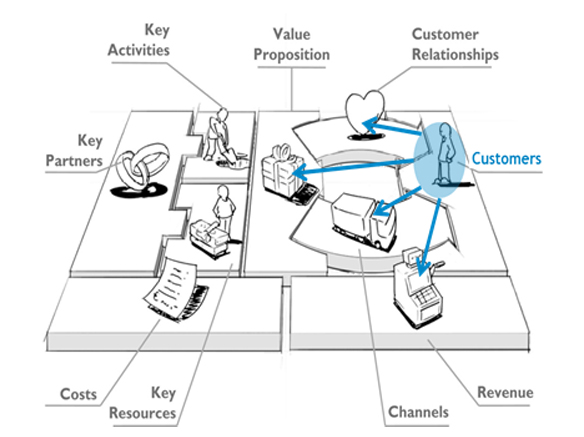
So, the challenge I focused on was…
Understanding the customer perspective in order to inform choices about Value Propositions, Channels, Customer Relationships and Revenue Streams.
And I thought about which methods might be most relevant, and put together a sample method set.

First, we need to identify the (right) Customer Segments. Stakeholder Mapping is a great tool for visualising the different roles and relationships within a ‘system’ (e.g., a project, a programme of work, etc.). We can use this to not only identify the different types of customers who would be interested in the Value Proposition, but also help identify potential Key Partners and Key Resources.
Identify Customer Segments

Next, we need to understand the customers’ needs. Contextual Inquiry is the method of choice as it involves interviewing AND observing people in their real environments, which is the best way to see unmet needs as well as articulated problems. Likewise, Walk-a-Mile-Immersion (WAMI) is one the best methods for building empathy for customers, so I’ve added that too.
If you’ve developed your Value Proposition (VP) to the point where you know the different features you could include, and have a rough idea of costs for implementing and supporting those features, then you could conduct Buy-a-Feature with customers to understand what they value, and what trade-offs they make when considering the costs and benefits of different features. Or, if your VP is still being formulated, you could conduct a What’s on Your Radar to understand the relative importance of problems (or solutions) to your customers.
Understand Their Needs
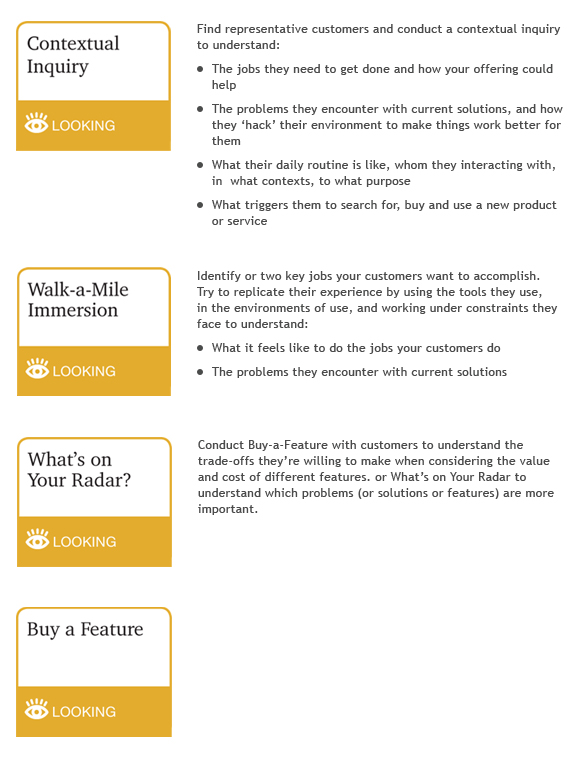
Of course, with all that rich data and insights, we need to analyse it in such a way that we don’t lose the human element. Numbers and statistics don’t let us understand our customers’ needs and motivations and how they might respond to changes in the Value Proposition, Channel, Customer Relationship and Revenue streams. Persona Profiles are a great way to humanise and communicate the findings from research.
Analysis & Humanise
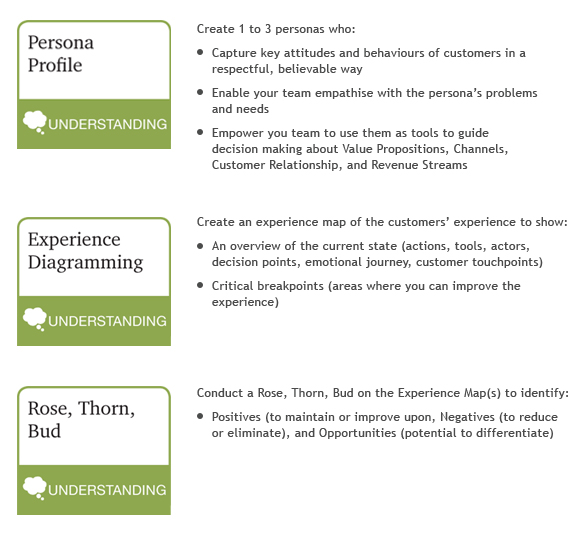
I adapted the Persona Profile slightly to better accommodate the BMC guidelines, which says you should have a separate business model for each customer segment. You’ll need to separate your customer groups into different segments if they have different needs that require different Value Propositions, if they’re reached through different Channels, if they need different kinds of Customer Relationships, if they have different profitabilities, or if they are willing to pay for different aspects of the offer.
Of course Persona Profiles can be used to help the team understand the different needs of different customer segments as well as the variances of needs within a segment. Because I suspect that there won’t be as much (large) variation within a single customer segment (as defined by the BMC), I’ve recommended that people create 1 to 3 Personas, rather than the usual 3 to 5. Naturally the ‘exact’ number depends on the complexity of the Business Model and the heterogeneity of a customer segment, so it’s a ‘soft’ recommendation.
The last method I’ve suggested is the Importance/Difficulty matrix, which I’ve adapted slightly so that you could use it to sense-check a Value Proposition (and ‘pivot‘ if warranted). Typically people use this method to rank the relative importance of problems (or needs) against the cost (or difficulty) of making and delivering different solutions (or features).
Prioritise
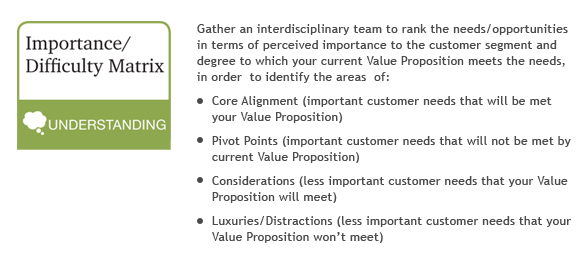
But it could also be used to rank customer needs in terms of relative importance (from the customers’ point of view–which problems/needs are more important) and the degree to which the (currently envisioned) Value Proposition meets those needs. The matrix can help prioritise or re-direct effort to areas of High-Importance, and de-escalate lower importance ones.
In the matrix below, I’ve named the quadrants according to the relationship of the Customer Needs to the Value Proposition. High importance needs that the VP is meeting to high degree are considered Core Alignment needs, meaning that effort should be directed towards ensuring that the VP continues to meet them. Less Important needs that the VP is meeting to a high degree are Considerations (i.e., depending on the degree of effort needed to implement them should be considered but not to the detriment of the Core Alignment areas). Low Importance needs that the VP is not meeting to high degree are Luxuries. And, High Importance needs that the VP is not meeting to high degree are Pivot Points (opportunities to adjust the VP).
Of course there are lots of other methods that could be used to tackle the challenge, depending on knowns, unknowns, timelines, budgets and many other factors! This was just an initial effort to see how I could map some HCD methods to the BMC.
Any (constructive) feedback or suggestions are welcome! Has anyone else tried something similar? Tweet @pddinnovation #HCDMashup


